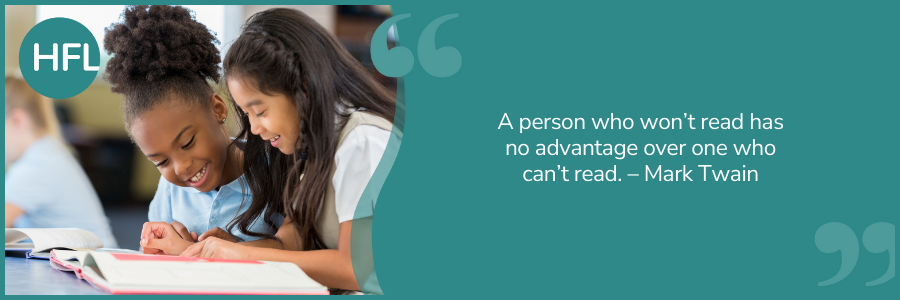
The phrase “it takes a village to raise a child” originates from an African proverb and conveys the message that a team of many is required to promote an environment of security, ambition and enthusiasm which encourages children to grow and pursue their hopes and dreams.
This was definitely the case with the promotion of 'reading for pleasure' in our school. Nothing was going to be achieved by one person in isolation. It was going to be an ongoing journey for the whole school and the community around us to change our ethos. It was not going to happen overnight.
I became English lead in June 2021 and was a passionate advocate of the power of books within our curriculum. The right texts on our shelves and throughout our curriculum would provide an insight for the pupils into all our school values: growth, cooperation, inclusion, ambition, independence and curiosity. The right texts should provide images of all pupils as champions in their own lives and support them to build empathy with the lives of others.
My initial step, with support from HFL Education advisers, was to take a walk around our wonderful school to take a fresh look at the literature available to our children. Although we had many texts on the shelves, it was clear that these could do with updating to represent a more diverse range of protagonists and authors. It was also obvious that the global pandemic had changed our collective use of the library and had heightened the need for a wider range of genres and text types within classroom ‘book corners’ to inspire and re-engage children in books.
So, we started small! I put a box full of new and diverse picture books in the staffroom with a star rating review sheet for the staff. I also put in a range of books that they might want to read for themselves, just to remind people of the joy that reading can bring on a personal and individual level. The ‘Book Fairy’ started delivering wrapped books to each class at the start of each half-term which created a buzz of excitement amongst the children and teachers! What were they going to receive next? Most importantly, we prioritised reading by giving teachers and children the time to just read and enjoy. Across the school, tweaks were made to the timetable to ensure this could work.
Alongside these changes to motivate and enthuse teachers and children to read, we developed our guided reading lessons and implemented a new phonics programme. This was a collaborative piece of work, alongside our feeder infant school, to ensure children who required further phonics instruction would continue to have a consistent approach on arriving at our school.
Then, we had to turn to our village…
With encouragement from SLT, our governors, a local English hub school and HFL Education, we began our journey to improve our range of ‘real’ books and inspirational literature on our shelves and in each classroom. We were clear that the focus of any money spent on developing our reading for pleasure culture was to be on books themselves.
As a junior school, we wanted the pupils to experience how to make informed choices about their reading materials in the same way that adults would if they were to go into a bookshop and scan the shelves. Each teacher had autonomy over their own classroom environments, and I think you will agree that the end results were worth their efforts:
- reading for pleasure
- whole school approach
- engaging, diverse and relevant literature
- organised to support choice


Reading was clearly elevated to centre stage within each classroom. Children were talking about books and year groups and staff were swapping texts. We next wanted that motivation, enthusiasm and engagement to grow and help our school community to come together with a shared understanding of the joy of books.
Alongside our values and whole school ethos, we wanted to use texts in our weekly assemblies. With the support of our Deputy Head, Mr Chris Amoss, we mapped out a cycle of texts that linked to a weekly value and world or school event. This became the weekly text that was displayed in the hall, linked to each daily assembly and was read and referred to by different members of staff each day. These texts were also linked to our whole class guided reading curriculum, our PSHE curriculum and several cross-curricular subject areas. Through these text choices, children are now able to make connections, develop vocabulary through repeated exposure and see links between the books they are reading and other areas of their learning.
A great example was when our Computing Lead, Mr. Adam White, shared Troll Stinks by Jeanne Willis and Tony Ross on Internet Safety Day. This great, child-friendly picture book got everyone talking about safe use of their phones and the importance of using kind words on online platforms. We also shared the Little Leaders: Ada Lovelace biography, for Ada Lovelace day. This gave great cross-curricular links with science and shared female STEM figures, underpinning our school values of ambition and growth.
The impetus of these changes continues to grow: there is a buzz about reading and books in the whole school that is taking off. Staff, governors and pupils are all talking about the importance of reading for pleasure and more importantly the pleasure they themselves are getting from reading! Children are developing knowledge of different genres and text types and can now be heard making recommendations their friends, saying: “If you liked this, maybe you could try this next.”
Our reading journals now contain conversations between teachers, children and parents about new vocabulary they have learned together, or what they particularly enjoyed about a certain text or a favourite character. They ask their class teacher as an ‘expert’ reader for recommendations of what to read next.
Furthermore, the conversations in the book corners are now about the books. We’ve overheard:
- “Have you read this?”
- “Do you prefer graphic novels to non-fiction books?”
- “Have you read the latest football book that came in?”
- “You know that book that we have been reading in English, well, there is another by the same author on the shelf! Are you going to read it next?”
- “Mrs. Atkinson, have we got the next in this series of books?”
- “I really think I prefer mystery and adventure type stories rather than animal books!”
With the support of our village, who knows where we can go next! The journey to changing our attitude and motivation towards reading for pleasure is just beginning but there are plans afoot. It cannot be accomplished by an individual, rather it takes a whole team of people behind a common goal.


